The Queen's Gambit - The final Game: Harmon vs Borgov Analysis

I spent the last 3 days binging The Queen's Gambit on Netflix. It's a drama about an orphan chess prodigy named Beth Harmon and her quest to become the world's greatest chess player.
Spoilers ahead!
In the final episode Beth plays against her arch nemesis, the Soviet chess player Borgov. From the show's Wikipedia, we learn that Garry Kasparov and chess coach Bruce Pandolfini acted as consultants, so that the actual games seem realistic.
Together with Lichess's computer analysis I go over the final game and try to analyze it. I'm a chess enthusiast, and not very good, so I thought this would be a great way to sharpen my skills and learn a thing or two. I hope you enjoy this analysis from a beginner's perspective.
The Game:
A part of the game was not shown in the show, so I tried to be smart and deduce what happened, and I think I'm not that far off! But more on that later.
Analysis
After researching this game, I found out on Twitter that it was based on a game from 1993. The specific game is Ivanchuk vs Wolff at the 1993 Biel Interzonal. On Chessgames.com you can check it out.
It starts out with Beth playing 1. d4, which makes sense, as it's the start of the Queen's Gambit opener. The complete Queen's Gambit starts with 1. d4 d5 2. c4, which are indeed the next moves. It's remarkable that in all the other games, Beth always played 1. e4.
Borgov then has the option to either accept the gambit by playing 2...dxc4
After 3. e4 Nc6, Beth's center pawn is under a double attack by both the Queen and the Knight. This is why she decided to bring the Bishop into it to defend the center pawn with 4. Be3. Borgov plays 4... Nf6.
Then it's 5. Nc3, again defending the other center pawn on e4, followed by 5...e5, putting the pawn on d4 under more and more stress.
By playing 6. d5, Harmon gains more space in the center, and attacks Borgov's knight which has to move. Borgov plays 6....Ne7. The stockfish engine on Lichess says this is an inaccuracy, as 6...Na5 might've been a better choice it says. Who am I to go against a chess algorithm, but 6...Ne7 seems okay as you still have your knight in the center of the board where it's more dangerous.
Beth replies by capturing the pawn on c4 by playing 6. Bxc4, followed by Borgov repositioning his retreated knight to 7...Ng6
By playing 8. f3, Harmon has a very strong center with the diagonal pawns. Over the next few moves, both players keep developing their pieces: 8...Bd6 9. Qd2 Bd7 10. Nge2.
Borgov plays 10...a6, planning to develop the queen side of the board, planning b5 later on. In anticipation to this, Beth removes her bishop from c4 by playing 11. Bb3, which is indeed followed by 11...b5.
Players continue developing, with a little attack by Elizabeth first: 12. a4 O-O 13. O-O Qe7.
Beth brings her Rook into position by playing 14. Rac1. Borgov brings his Knight to the sides with 14...Nh5. From this point you can see that the tension is building, particularly on the f4 file, with Borgov's 2 knights, the e5 pawn and the bishop.
Harmon strengthens the f4 square by pushing the g2 pawn up with 15. g3 h6. Vasily Borgov continues to build his positioning with this.
This is followed up by 16. Bc2 Rab8 and a simple exchange with 17. axb5 axb5 18 Ra1 Ra8. This quick exchange is fairly normal, followed by Beth's Ra1 move to get control over the A-line, possibly later bringing the rook to a7 where it is defended by the bishop on e3.
According to Stockfish, Vasily's Ra8 move was another small inaccuracy, where Borgov's move was purely intended to block Beth from going Ra7 straight away. Playing 18...Bh3 would most likely result in 19. Rf2 according to Stockfish, but it's not entirely clear to me why. Any suggestions here?
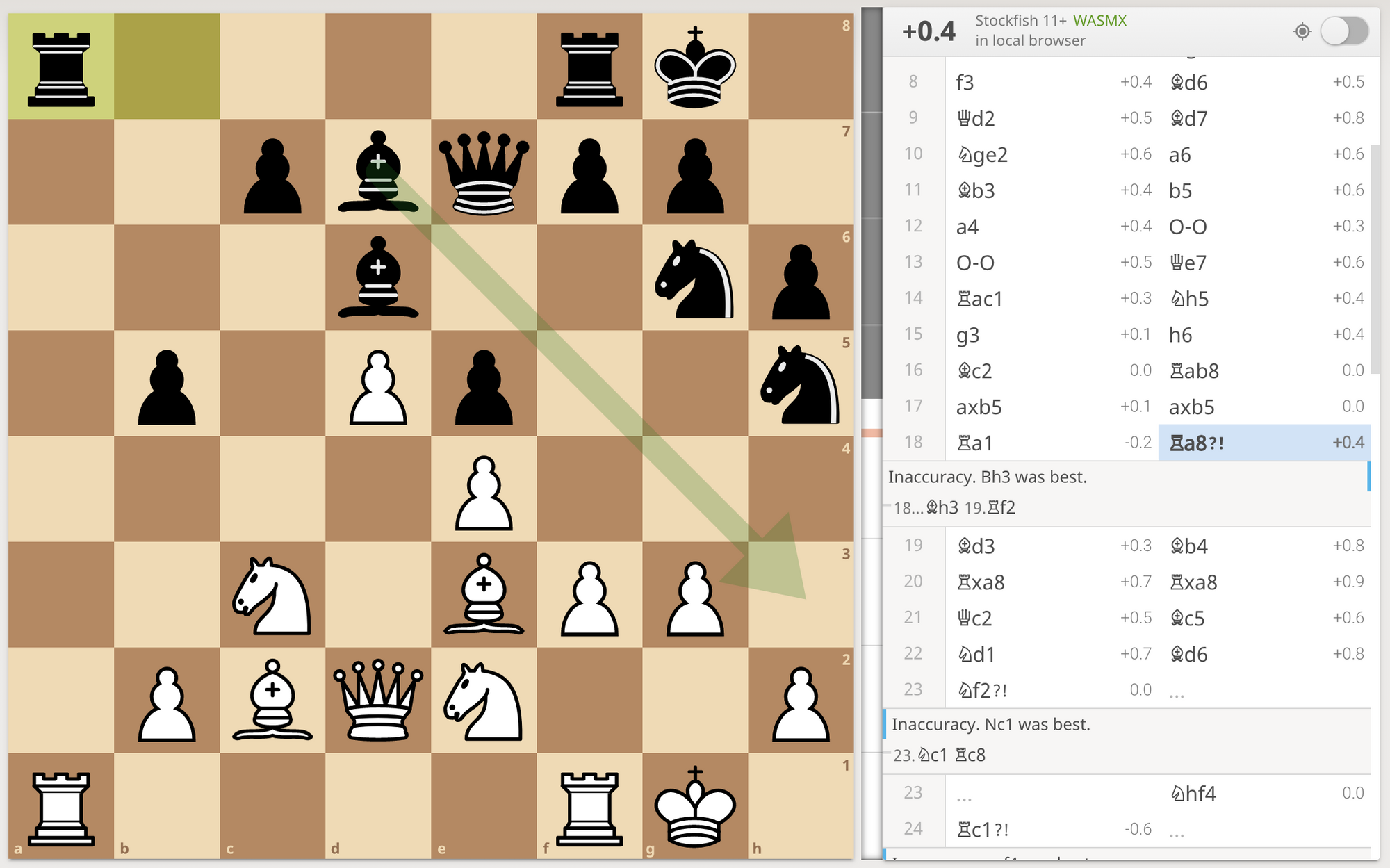
Instead the game continues with 19. Bd3 Bb4, first Harmon putting pressure on the b5 pawn, but Vasily pinning the knight to the queen, thus making it immovable.
Then we get rook captures with 20. Rxa8 Rxa8.
Beth moves her queen to 21. Qc2, thus removing the pin on the knight and now the pawn on b5 is again under attack. Because the queen isn't guarding the bishop on e3 anymore, Borgov plays 21...Bc5. This means that Beth can't go after the b5 pawn anymore because imagine she does: 22. Bb5 Bb5 23. Nb5 Be3, Borgov captures 2 bishops and Beth only gets a bishop and a pawn. So what she needs to do is find a way to defend the bishop on e3. She can't capture the bishop on c5 (22. Bc5, because Borgov will capture it with 22...Qc5, checking Beth and gaining control of the center with the Queen.
Instead, Elizabeth plays 22. Nd1, so she defends the Bishop on e3. The pawn on b5 is not being attacked anymore with the knight gone. Now Borgov either has to move the bishop on c5 to a safe place or go for the trade with 22....Be3. However this is not a good idea, because then Beth brings the Knight on d1 into play with 23. Ne3, and now this knight has a lot of space to move to.
Instead Borgov goes for 22...Bd6, retreating the bishop to a safer place.
Beth's next move, 23. Nf2 is considered another inaccuracy, as Stockfish suggests 23. Nc1. But Nf2 improves the position of the knight so this seems reasonable to me.
Then we get the first really interesting and beautiful move of the game. 23...Nhf4, basically suggesting to Harmon to capture it.
In fact, Lichess' engine suggests that the knight should be captured by 24. gxf4.
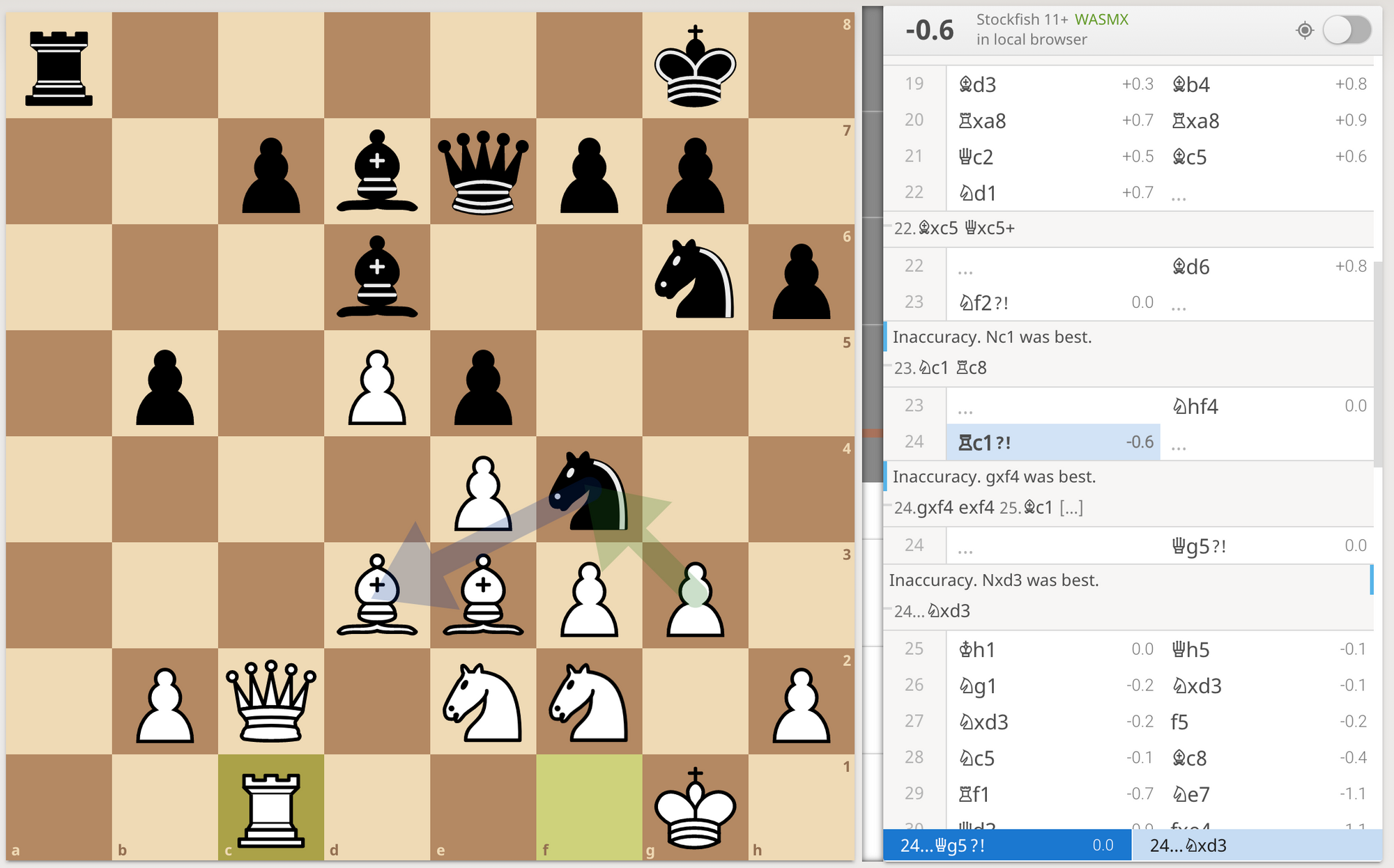
The thing is, by doing this you get a whole different game, where white will position itself into a position where it will have to defend, because we have Black's queen and bishops on the right lines to go for the attack then.
Beth not being the defensive kind of player decided to ignore the knight on f4 and plays 24. Rc1, ignoring Borgov's request to go for a trade.
Borgov continues the attack with 24. ...Qg5. Now you can see that Borgov is preparing the attack and also that the bishop on e3 is still a minor problem for Elizabeth. When the black kngith on f4 moves later on, the bishop on e3 is undefended and could be captured by the queen.
The next moves are 25. Kh1 Qh5. Elizabeth doesn't allow Borgov to check her with a Nh3 move. With the Qh5 move Borgov again leaves the knight undefended, but capturing it would be a terrible mistake and an awful play by Elizabeth resulting in a checkmate:
26.gxf4Qxf3+
27.Kg1Nh4
28.Kf1Qg2+
29.Ke1Nf3+
30.Kd1Qf1#
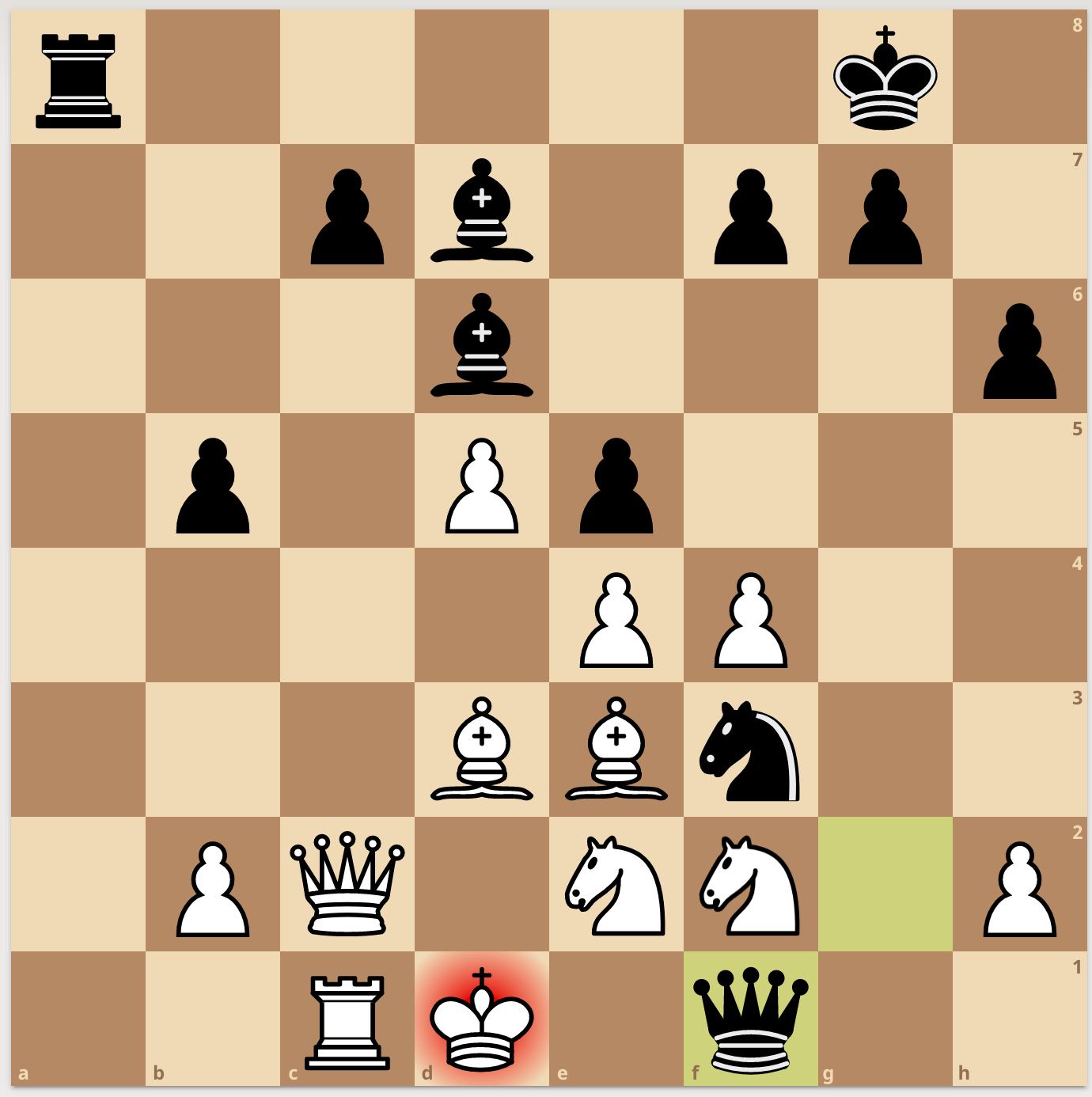
Instead what Elizabeth does is 26. Ng1, and the knight goes for the capture on d3 by 26... Nxd3.
We get a recapture with 27. Nxd3. Borgov then pushed the pawn 27...f5.
Then Harmon puts the pressure on Borgov with 28. Nc5, threatening to capture the bishop on d7. An exchange would not be beneficial to Borgov, so he moves his bishop away to 28...Bc8.
29. Rf1 is for in case the f-file opens up, as it's more valuable there than on the c-file for now. 29...Ne7
The next move, 30. Qd3, moves the pressure back on the pawn. There's not so much Borgov can do, and he goes for the capture with 30...fxe4 31. Nfxe4 Qg6. We get a recapture with the pawn by Beth, and the queen to g6 disallows her to go capture the pawn on b5, as it would ultimately let the pawn on e3 be open for capture by black and letting him gain advantage.
On move 32 both parties improve the position of their kings, with 32. Kg2 Kh7. Especially the white king now has more wiggle room to move around.
33. Nf3 Ng8, is a move by both parties to prepare the attack. On the previous spots the knights were somewhat out of play and you can see that they both want to reposition their knights.
Beth does so by 34. Nh4, attacking the queen. This was an inaccuracy it seems, as statistically h3 was a better move it seems.
Now Borgov wanted to move his knight to f6, but with the attack on the queen he first has to bring her to safety. He does this by playing 34...Qg4.
Beth moves her knight to f5, with 35. Nf5, really positioning it very well in the center with a lot of defenders (pawn, queen, rook). Also by this, the black bishop on c8 is looking rather odd, with no place to go.
We get 35...Nf6 by Borgov, where Stockfish would've added the rook on a8 into play by 35...Ra2
Anyway, so now Beth finally plays the pawn to h3 (36. h3) (which was suggested by Stockfish a little bit earlier). But this time it really adds to the game because it adds more pressure to the queen, thus letting Beth keeping the pressure on Borgov and leaving him in a "responding" state where he constantly has to respond to Beth's moves by moving his queen instead of really playing the moves he wants to play.
This is also the point where Borgov decides to adjourn the game. Fun fact: adjourning is not something that is done anymore in chess, because it can of course be used to analyse the game over the night (with a chess engine like Stockfish). We see in the show that both Borgov and Beth do analyse the game with fellow chess players, which would be a little bit cheating nowadays.
When they resume the play the day after, the move Borgov wrote on the piece of paper was 36...Qg6.
Remember when I told you previously that this game was based on another game that was played in real life? It's actually up to this point the games are the same. But because the real life game ended up in a draw, and that would be a lousy ending for the show, the Beth plays another move.
She goes 37. Ne6, and Borgov brings his rook into the game with 37...Ra4, going after the e4 pawn, the center of the white position.
Elizabeth plays 38. b3, which is actually such a wonderful move, basically telling Borgov "what you want to do?". The pressure is on Borgov, he can go for the check, capture the e4 pawn with rook or knight, etc.
Borgov decided to capture the central pawn on e4 (38...Rxe4) that's been the foundation of Beth's whole position.
Beth plays 39.Nxd6, essentially going for the future fork, by playing the knight to f8. However Borgov ancticipates this and captures the troublemaker by playing 39...Bxe6.
By doing this, Harmon can advance her pawn, which is exactly what she does with 40.dxe6, but she loses her last knight with 40...cxd6.
She doesn't wait and advances the pawn further, 41. e7, being only one file away from promotion. However as you can see promotion would be useless, because the e8 square is protected by the black knight and queen, so Borgov doesn't have to worry about that - for now. He instead plays 41...d5, so that his rook gets extra protection, as Elizabeth could easily get distract his knight and queen.
It's at this point that Elizabeth starts her ceiling analysis, as at this point she is on her own, and the d5 move is such a powerful move that she needs to consider her next options.
Elizabeth responds by playing the equally beautiful 42. Bc5, preparing the advancement of the white b-pawn and defending the e-pawn on its current spot. Black really doesn't have a lot of possible plays here. Moving the rook is out of the question because white can easily trade queens and capture the knight with the rook in order to promote the pawn.
So black decided to play 42...Qe8.
White plays 43. Qf3, as the pawn on b5 is defended by the queen anyway now.
43...Qc6, to attack the bishop and 44. b4 to defend the bishop.
And then we get the first big mistake of the game. The only correct move would be 44. Kg8, basically waiting for white to see what they're gonna do, but he decides to play 44...Qe8.
It's also around this time Borgov offers a draw which is declined by Beth. And rightfully so.
45. Qf5+ for the check.
Now Borgov has some options. A possible option would be 45...Kg8, but in a few moves this can lead to this situation which is basically game over for him:
45...Kg8 46.Qe6+ Kh7 47.Rxf6 gxf6 48.Qxf6
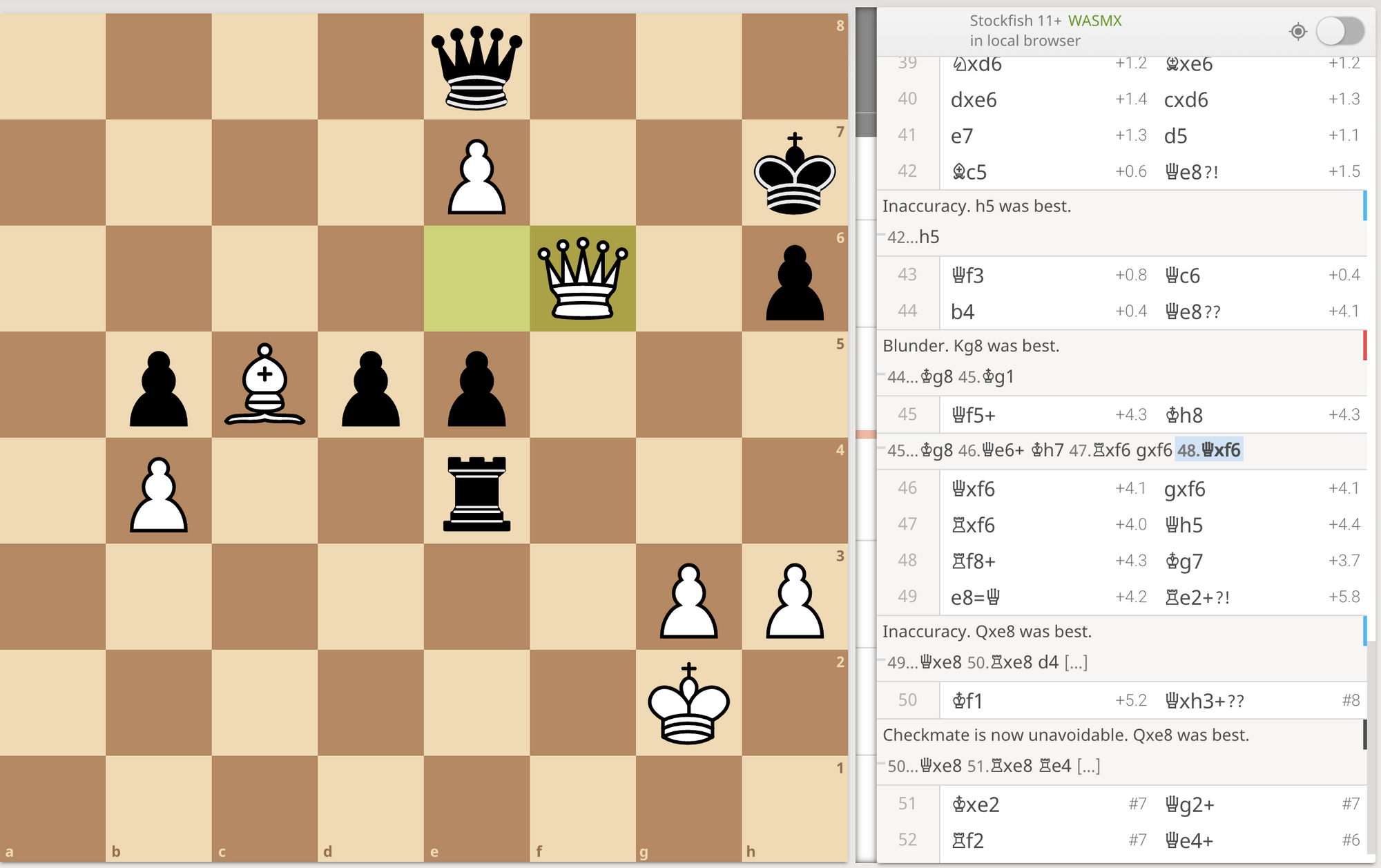
Instead he plays 45...Kh8
And here Elizabeth shows how good she is at chess.
This is the current situation:
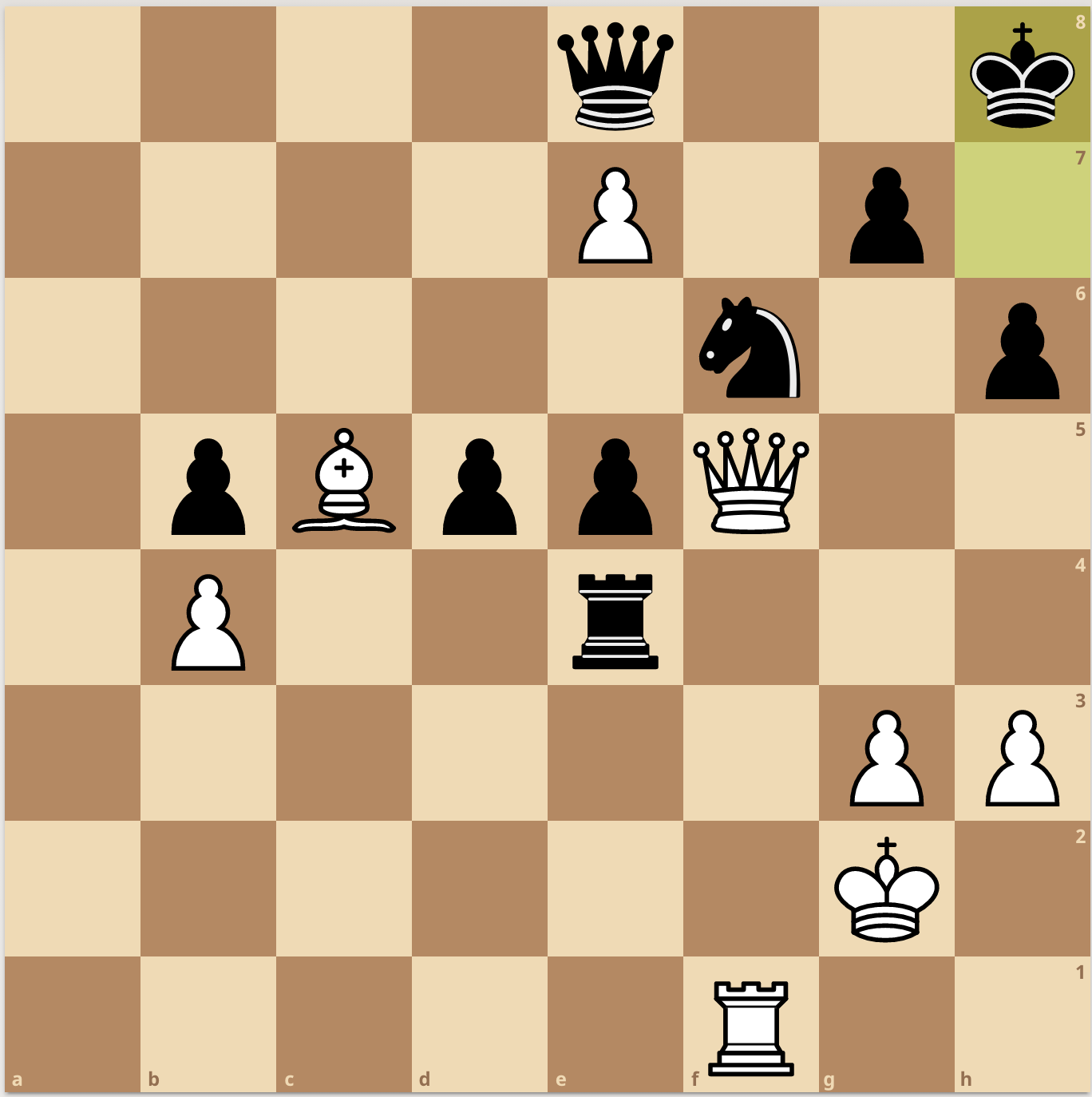
And she decides to play the wonderful move of 46. Qxf6, sacrificing her queen. We get the expected sequence of 46...gxf6, 47. Rxf6.
Borgov advances his queen to 47...Qh5, assumingly trying to go for the attack with the rook. The expected check with the rook is coming with 48. Rf8+, and black moves the king to 48...Kg7
Elizabeth promotes the pawn to a queen (49, e8=Q).
From this point on it requires some speculation because it's not 100% clear what happened in the meantime. This is what they showed in the episode.
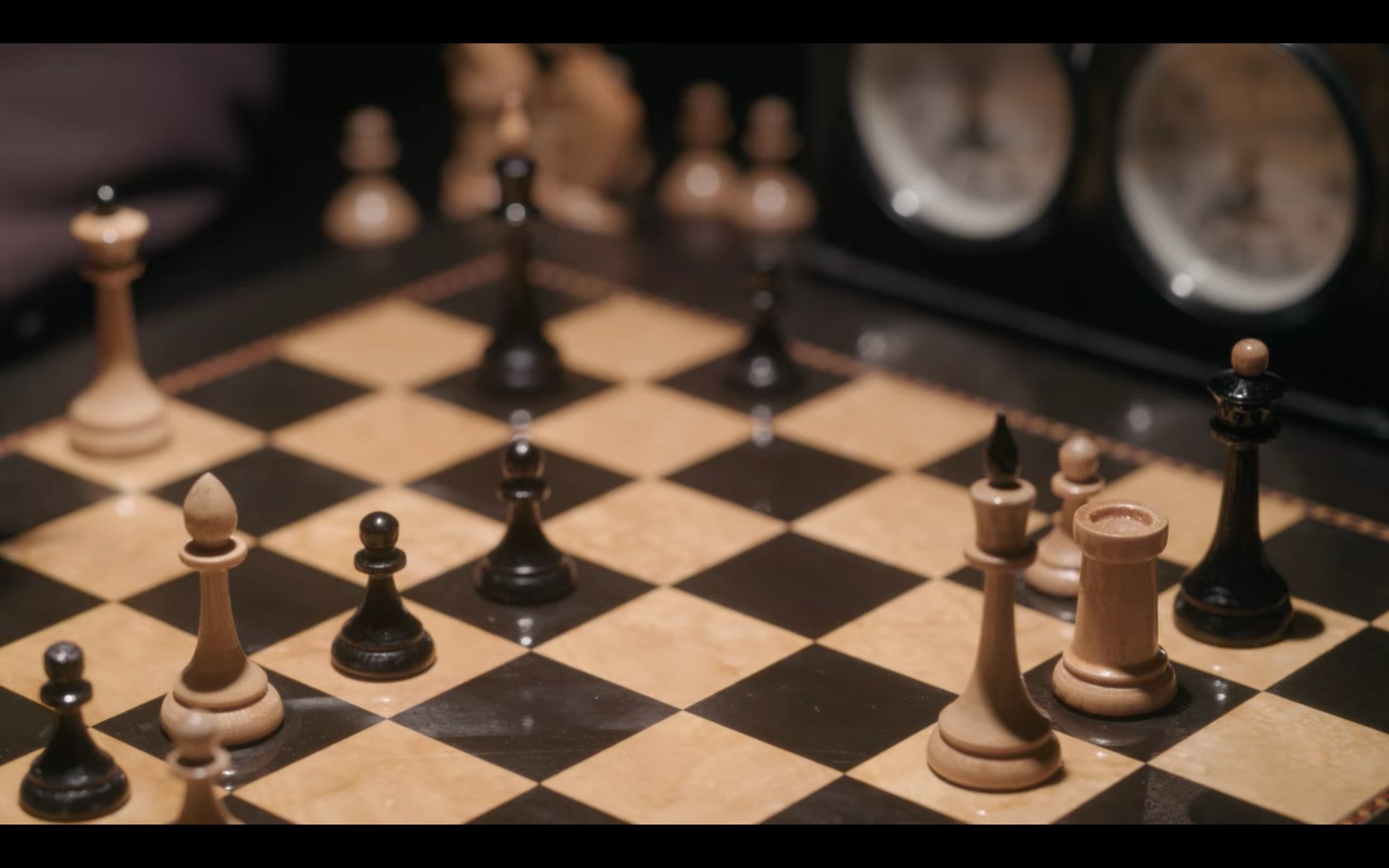
We can see that the black rook is gone, and the black queen captures the h3 pawn and came down to the second line.
What I assume happened is the following:
49...Re2+
50. Kf1 Qxh3+
51. Kxe2 Kg2+
The only way black can win now is if he can make Elizabeth make a mistake and let her move her king towards the black pawns. But she decides to block the threat with the rook.
52. Rf2
At this point we have the position where we are in now.
We then get 52...Qe4+, assuming that Borgov was hoping Elizabeth did not see the overwhelming advantage she had and would love to go for some draw instead.
But luckily she kept her cool and slowly played the last move of the game:
53. Kd2
Borgov has no way to attack the white king in any way: either the rook or the bishop blocks it. The only thing left for him to do is to resign and let Beth become the world champion, which he did.
Analysing a game afterwards is fun but also of course a lot easier with a chess engine next to you. There's of course no way I would've lasted than 15 moves against either fictional player 😅.
If you haven't seen the show yet, it's a Netflix original so it will probably be indefinitely on Netflix. However, if you like chess, I must say it's one of the most fun series with chess as the subject I've seen.
Hope you liked this breakdown, and stay safe.

